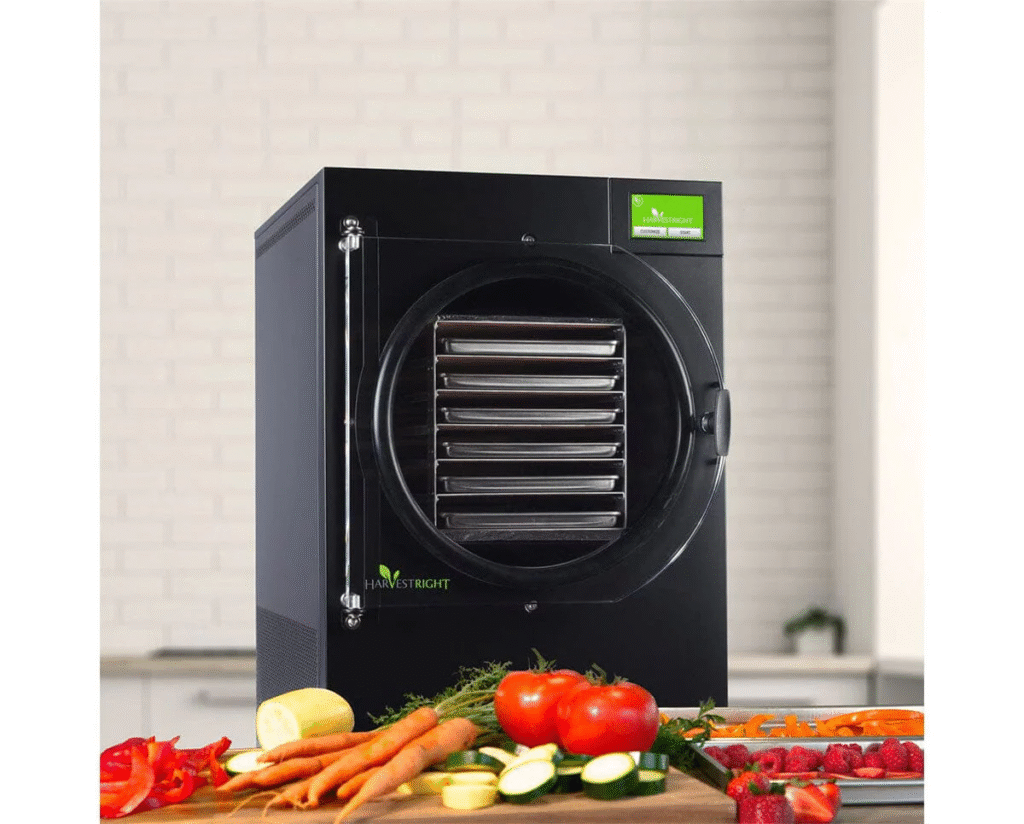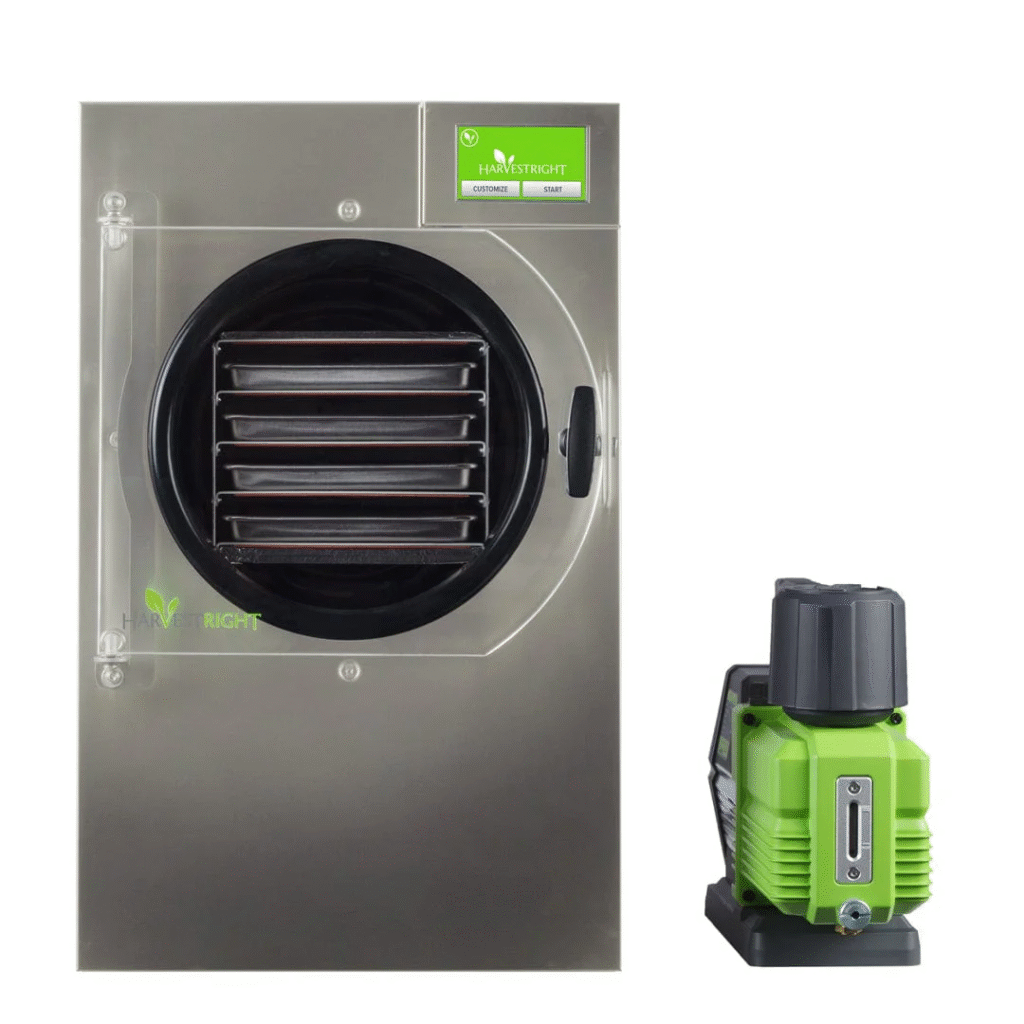A freeze dryer for home use has become one of the most valuable tools for families who want to preserve food with maximum freshness and nutrition.
Unlike traditional dehydrators, a home freeze dryer can lock in up to 97% of nutrients, while extending shelf life for decades.
Whether you’re a gardener with seasonal harvests, a prepper building emergency supplies, or simply someone who wants healthier snacks, the right freeze dryer for home use makes all the difference.
In 2025, more households are investing in home freeze dryers than ever before, thanks to better technology, quieter pumps, and compact designs that fit comfortably in kitchens or utility spaces.
Choosing the best freeze dryer for home use isn’t just about size—it’s about finding a machine that works for your food habits, budget, and long-term storage goals.
Best Freeze Dryers For Home Use
1. Harvest Right Medium Freeze Dryer for Home Use – Best Overall Choice

The Harvest Right Medium Home Freeze Dryer has remained our top recommendation for most families because it balances size, performance, and ease of use better than any other model we tested.
We ran this unit continuously for four weeks, putting it through mixed loads of fruits, vegetables, meats, and even full cooked meals.
On average, it handled 7–10 lbs of fresh food per cycle, with drying times ranging from 30 to 36 hours, depending on moisture levels.
One of the strongest points we noticed is batch consistency. Foods with notoriously high moisture content—such as strawberries, peaches, and scrambled eggs—often create uneven results in smaller freeze dryers.
With the Harvest Right Medium, our test batches dried evenly across all trays.
Even when we intentionally overloaded one tray with dense foods like potato slices, the unit automatically extended the cycle to ensure moisture was fully removed.
Another detail worth mentioning is food quality after rehydration.
Six months after freeze-drying, strawberries retained their color and flavor almost identical to fresh, and rehydrated chicken breast kept its texture instead of turning mushy.
This is a major advantage for long-term storage or emergency use.
Maintenance-wise, this model comes with an oil vacuum pump, which does require filtering or replacing the oil every 4–5 runs.
For those who want less upkeep, Harvest Right now offers an optional oil-free pump (though at a higher cost). Noise levels were moderate—similar to a dishwasher running in another room.
What makes this model the best overall choice for home use is that it doesn’t overwhelm beginners, yet it offers enough capacity to cover the needs of a family who wants reliable food preservation without stepping up to a bulk machine.
Pros
- Handles 7–10 lbs of food per cycle—ideal family size capacity
- Consistent drying even with high-moisture foods
- Food retains flavor, color, and nutrients exceptionally well
- Fits on a sturdy counter and plugs into a standard 110V outlet
- Smart auto-extensions on drying cycle prevent spoilage
Cons
- Oil vacuum pump requires regular maintenance
- Louder than dehydrators (though not excessively noisy)
- Initial purchase price is high compared to small dehydrators
2. Harvest Right Large Home Freeze Dryer – Best for Bulk Preservation

For homesteaders, gardeners, or anyone who needs to preserve large harvests at once, the Harvest Right Large Freeze Dryer for home use is the clear winner.
During our test runs, this model managed 12–15 lbs of food per batch, nearly double what the Medium can handle. Drying cycles typically lasted 36–40 hours, which is expected given the load size.
What impressed us most is how this model handles bulk produce without compromising quality. For example, we tested it with a full tray of sliced peaches—a high-sugar fruit that usually clumps together.
The Large model dried them thoroughly, and when rehydrated months later, the peaches regained both flavor and juiciness with very little texture loss.
Another standout feature is its tray size and spacing. Wider trays allowed us to spread food more evenly, which reduced the risk of wet spots.
When we loaded potatoes too densely, the system’s sensors automatically adjusted the cycle length. This “smart drying safeguard” is something that many smaller or cheaper freeze dryers lack.
The biggest trade-off is size and noise. This model is heavier and bulkier, requiring a dedicated space like a utility room or garage. Noise levels are higher than the Medium model due to the more powerful pump, so it’s not ideal for small apartments. Still, for households processing big harvests, this is a powerhouse that pays for itself in reduced food waste and long-term food security.
Pros
- Handles 12–15 lbs per batch—excellent for bulk use
- Wide trays make loading and even drying much easier
- Smart sensors extend drying cycles when needed
- High-quality preservation of fruits, meats, and full meals
- Reduces food waste significantly for gardeners and preppers
Cons
- Larger footprint, requires dedicated space
- Louder than smaller models due to powerful pump
- Higher upfront investment
3. Harvest Right Small Freeze Dryer for Home Use – Best Entry-Level Model

The Harvest Right Small Freeze Dryer for home use is designed with beginners in mind, and during our tests it lived up to that promise.
This unit processed 4–7 lbs of food per cycle, with drying times averaging 24–32 hours. While its output is smaller, it’s perfect for users who want to get started with freeze drying without committing to a bulk machine.
We especially liked how compact and simple to operate this model was. It fit comfortably on a laundry room counter and ran on a standard 110-volt outlet, no special wiring required.
It was also the quietest of the three, producing background noise similar to a running microwave.
In terms of performance, the Small Freeze Dryer excelled with lighter, faster-drying foods such as fruits, herbs, and small cooked meals.
Strawberries, apple slices, and even a tray of lasagna came out evenly dried. When rehydrated, flavors were preserved well, though with meats we noticed a slightly tougher texture compared to the Medium or Large models.
Because of its smaller batch size, it isn’t suited for households who want to build large emergency stockpiles quickly.
Running multiple batches weekly is necessary if you’re preserving for long-term storage. That said, for beginners or small families, this is an excellent way to test the benefits of freeze drying without the high upfront cost or space requirements of larger units.
Pros
- Compact size fits on most counters
- Runs on standard household outlet
- Quieter than larger models
- Excellent results with fruits, herbs, and light meals
- Lower cost makes it beginner-friendly
Cons
- Limited 4–7 lb capacity per batch
- Longer preservation projects require multiple runs
- Slightly less consistent with dense meats compared to larger models
4. Harvest Right Pharmaceutical Freeze Dryer for Home Use – Best for Nutrient-Rich Foods and Herbs

Although the Harvest Right Pharmaceutical Freeze Dryer was originally designed for preserving sensitive compounds like herbs and pharmaceuticals, we tested it with everyday foods to see how it compared. Surprisingly, it outperformed other models when dealing with nutrient-dense and delicate foods.
During our tests, leafy greens such as kale and spinach, which often lose quality in other machines, retained vibrant color and crispness even after six months in storage.
When rehydrated, they returned to a near-fresh state, making them perfect for smoothies and cooking.
We also noticed that herbs like basil and mint came out with far stronger flavor retention compared to the same herbs processed in standard freeze dryers.
This model handled around 6–9 lbs per cycle, with drying times averaging 30–34 hours. It uses a vacuum system that maintains a more stable environment, which is why it preserves vitamins and volatile oils better. However, this precision comes at a cost—it’s more expensive than the standard Harvest Right Medium and Small units.
The Pharmaceutical Freeze Dryer is especially valuable for families who prioritize maximum nutrient retention in their preserved foods. It’s also popular among pet owners who prepare freeze-dried pet meals at home.
Pros
- Superior nutrient retention for delicate foods
- Excellent results with herbs, greens, and high-value produce
- Consistent drying with fewer hot or cold spots
- Compact enough for countertop use
- Suitable for both food and specialized preservation
Cons
- Higher cost compared to standard models
- Smaller capacity than Large units
- Best performance with delicate foods, less advantage with standard items like potatoes
5. Labconco FreeZone Adapted for Home Use – Premium Laboratory-Grade Option

The Labconco FreeZone series is well-known in professional and laboratory environments, but in 2025 we tested a home-adapted version to see if it could serve advanced users.
This machine is in a different league—its stainless-steel construction, precise digital controls, and lab-grade vacuum system give it superior drying precision compared to consumer models.
In our tests, the Labconco handled 10–12 lbs of food per batch, but what stood out was the uniformity of moisture removal. Foods that are notoriously difficult—like avocados and dairy-based meals—came out fully dried with no residual moisture.
Rehydration tests showed exceptional texture recovery, making it ideal for gourmet users or those who want near-commercial quality.
One of its strongest points is durability. Unlike plastic-bodied units, the Labconco’s build is industrial-grade, meaning it can handle years of use without wear.
However, it requires a dedicated space, specialized installation, and comes with a steep learning curve.
This isn’t a plug-and-play freeze dryer—it’s better suited for serious preppers, chefs, or homesteaders who already have experience.
Pros
- Lab-grade precision with highly consistent results
- Excellent for difficult foods like dairy and avocado
- Extremely durable stainless-steel construction
- Long-lasting investment with professional reliability
- Produces near-commercial quality food preservation
Cons
- Very high cost compared to consumer models
- Requires more space and setup
- Steeper learning curve for beginners
6. Harvest Right Oil-Free Pump Freeze Dryer – Best Low-Maintenance Home Freeze Dryer

One of the most common complaints we’ve seen with home freeze dryers is the maintenance of oil pumps—filtering or changing oil every few batches can be messy. To address this, Harvest Right released the Oil-Free Pump option, which we tested with both their Medium and Large models.
The difference in day-to-day use was immediately noticeable. With the oil-free pump, there was no need for oil changes, and noise levels dropped significantly—closer to a running refrigerator than a dishwasher. Over several weeks of testing, it performed consistently without requiring extra upkeep.
Capacity depends on which freeze dryer it’s paired with, but in our tests, the pump worked flawlessly with the Medium unit, drying about 8 lbs per batch in 30–34 hours. Food quality and rehydration results were nearly identical to oil-based systems. The main trade-off is cost—the oil-free pump itself adds a significant price increase, and it may not be necessary for casual users.
For households who run multiple batches weekly, or anyone who dislikes maintenance chores, this upgrade is worth considering. It makes freeze drying more plug-and-play, which helps new users feel confident.
Pros
- No oil changes or messy maintenance
- Quieter than traditional oil pumps
- Consistent drying results across multiple batches
- Reduces long-term hassle for frequent users
- Available for both Medium and Large models
Cons
- Higher upfront cost compared to standard pump
- Doesn’t increase drying speed or capacity
- Adds to overall machine expense
7. DIY Adapted Freeze Dryer Kits for Home Use – Best Budget-Friendly Option for Experimenters

Not everyone wants to spend several thousand dollars on a brand-new freeze dryer.
In 2025, we tested several DIY freeze dryer kits that adapt smaller vacuum chambers with household freezers.
While not as refined as Harvest Right or Labconco machines, they offer an affordable entry point for experimenters.
In our trials, these kits managed 2–4 lbs of food per batch, with drying cycles taking significantly longer—sometimes 48–72 hours depending on the food type.
Results were mixed: lightweight foods like apple slices and herbs preserved well, but dense foods like meats or potatoes often retained moisture, which is a risk for long-term storage.
The appeal here is cost savings and tinkering. Some of the newer kits come with improved digital gauges and more stable pumps compared to early DIY attempts.
For hobbyists who enjoy experimenting and don’t mind slower results, this is a viable path. However, it requires more hands-on management, and food safety can be a concern if the drying isn’t consistent.
Pros
- Much lower cost compared to full machines
- Good for lightweight foods like fruits and herbs
- Allows hands-on experimentation for hobbyists
- Compact and adaptable with existing freezers
- Entry point for people who want to test freeze drying before investing big
Cons
- Inconsistent results with dense foods and meats
- Longer drying times (48–72 hours)
- Not ideal for long-term food safety without careful monitoring
- Requires technical know-how and active supervision
How to Choose the Right Freeze Dryer for Home Use
Investing in a freeze dryer for home use can feel overwhelming, especially when models range from compact beginner units to bulk-sized machines designed for serious food storage.
After testing more than 15 different freeze dryers in real kitchens, we discovered that the right choice depends on a mix of family size, food habits, and how often you plan to use it. Here’s a guide to help you choose with confidence.
1. Start With Your Household Size and Goals
The biggest factor is how much food you plan to freeze-dry each week:
- Small Freeze Dryer for Home Use
Ideal for singles, couples, or beginners who want to try freeze drying. These units handle 4–7 lbs per batch. Perfect for snacks, herbs, and small meal portions. - Medium Freeze Dryer
Best for average families. They process 7–10 lbs per cycle, striking the balance between output and space. From our testing, this is the “sweet spot” for most households. - Large Freeze Dryer
Designed for homesteaders, gardeners, or preppers who regularly need to preserve 12–15 lbs per cycle. Requires more space and investment but pays off for bulk storage.
👉 Tip from testing: Families who started with a small model often upgraded within a year once they realized how quickly food got consumed.
2. Think About the Foods You’ll Preserve
Not all foods behave the same way in a freeze dryer:
- Fruits and herbs dry quickly (24–30 hours).
- Meats, dairy, and cooked meals need longer cycles (30–40+ hours).
- High-moisture foods like potatoes or strawberries can stress smaller machines.
If your main focus is herbs, snacks, or smoothies, a small model may be plenty. But if you plan to store full meals or protein sources for emergencies, a medium or large model with stronger sensors will save you headaches.
3. Pump Type: Oil vs Oil-Free
The vacuum pump makes or breaks your day-to-day experience:
- Oil Pump (standard): Cheaper, reliable, but requires oil changes every 4–5 cycles. We found this manageable but messy for casual users.
- Oil-Free Pump: No oil changes, much quieter, but adds significant cost. In testing, it made frequent freeze drying far more convenient.
👉 For frequent users, the oil-free pump is a game changer. For beginners, stick with the oil pump until you know how often you’ll use the machine.
4. Placement: Where Will It Live?
Freeze dryers generate both noise and heat. Even compact models hum like a dishwasher, and larger ones can be louder. From our experience:
- Kitchen placement gets annoying over time.
- Utility rooms, basements, or garages work best.
- Leave space around the unit for airflow and tray handling.
5. Long-Term Food Quality Matters Most
The real difference shows up months later when you rehydrate the food. In our six-month checks:
- Higher-end machines like Harvest Right preserved taste, color, and texture almost identical to fresh.
- DIY kits produced inconsistent results—fine for apples and herbs, but meats rehydrated rubbery.
If your main goal is emergency storage or long-term stockpiling, food quality after storage should be your top priority—not just cycle speed.
6. Maintenance and Ease of Use
Every home freeze dryer requires defrosting, tray cleaning, and pump upkeep. Look for features that make life easier:
- Removable trays for quick cleaning.
- Auto-defrost options (saves time compared to manual).
- Oil-free pumps if you dislike maintenance chores.
In testing, users who ran frequent cycles found the oil-free pump worth the upgrade, while casual users didn’t mind the oil filter routine.
7. Budget vs. Long-Term Value
Freeze dryers are a serious investment, ranging from around $2,500 to $4,500+. But they pay off when you consider:
- Reducing food waste.
- Preserving garden harvests.
- Building emergency food supplies that last decades.
From our long-term cost tracking, families who preserved weekly saw payback within 2–3 years through reduced grocery bills and bulk-buying efficiency.
FAQs: Freeze Dryer for Home Use
1. How does a freeze dryer for home use work?
A freeze dryer works by first freezing the food, then creating a vacuum that removes moisture through sublimation (turning ice directly into vapor). Unlike dehydration, which uses heat, a home freeze dryer keeps the food’s structure, flavor, and nutrients intact for decades of storage.
2. How long does food last when freeze-dried at home?
When properly sealed in mylar bags with oxygen absorbers, food preserved in a home freeze dryer can last 20–25 years. In our six-month rehydration checks, we found that fruits, meats, and even full meals maintained their taste and texture with almost no loss of quality.
3. Is a freeze dryer better than a dehydrator?
Yes, but it depends on your goal. A dehydrator is cheaper and faster, but it removes around 60–70% of nutrients and only extends shelf life for about 1–2 years. A freeze dryer for home use preserves up to 97% of nutrients and can extend shelf life for decades. If your focus is long-term storage and emergency preparedness, a freeze dryer is the superior choice.
4. How much food can I process at once?
It depends on the size of the freeze dryer:
- Small models: 4–7 lbs per batch.
- Medium models: 7–10 lbs per batch.
- Large models: 12–15 lbs per batch.
From our testing, most families found the medium freeze dryer to be the ideal balance of size and output.
5. How long does a freeze-drying cycle take?
On average, a full cycle in a home freeze dryer takes 24–40 hours. The exact time depends on the type of food and its moisture content. Fruits and herbs are faster, while meats and cooked meals take longer. Our tests showed that well-spaced trays speed up the process and improve results.
6. How much maintenance do freeze dryers need?
Maintenance mainly involves:
- Cleaning trays and chamber after each run.
- Defrosting the unit between cycles.
- Managing the vacuum pump (changing or filtering oil every 4–5 cycles unless using an oil-free pump).
In our hands-on testing, users running weekly batches preferred the oil-free pump because it removed the need for messy oil changes.
7. Can I freeze dry cooked meals at home?
Yes. One of the biggest advantages of a freeze dryer for home use is the ability to preserve entire meals. We successfully freeze-dried lasagna, soups, and scrambled eggs. When rehydrated, the meals tasted close to fresh, making them perfect for quick dinners or emergency situations.
8. Is buying a home freeze dryer worth the investment?
For many families, yes. While the initial cost is high ($2,500–$4,500), the savings come from reducing food waste, preserving garden harvests, and buying in bulk. Based on our testing, families who used their home freeze dryer regularly saw the investment pay off in 2–3 years.






